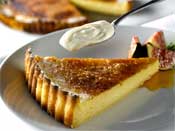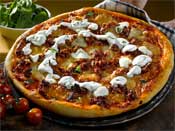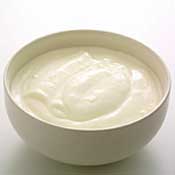FÉILE BIA - Ballymore Inn Lemon Tart / Lamb Pizza with Yoghurt and Mint / Yoghurt
 We all want to know where our food is coming from – the reasons why we need this information are increasing all the time, and now include issues that may not have seemed important until recently, such as food miles and genetically modified seeds; but, in view of scares such as BSE and worry about meat and poultry imports from countries without credible quality control systems, the most urgent concern remains the question of food safety.
We all want to know where our food is coming from – the reasons why we need this information are increasing all the time, and now include issues that may not have seemed important until recently, such as food miles and genetically modified seeds; but, in view of scares such as BSE and worry about meat and poultry imports from countries without credible quality control systems, the most urgent concern remains the question of food safety.
In 2001, Bord Bia (the Irish Food Board) - with the support of the Restaurants Association of Ireland, the Irish Hotels Federation, and the chefs’ association Euro-Toques - introduced the F�ile Bia programme for catering establishments. It’s a voluntary programme concerned with food sourcing in professional Irish kitchens, and consumers choosing to eat at any of the 1500 or so member hotels, restaurants, pubs etc throughout the country have the reassurance that the fresh beef, lamb, pork, bacon, chicken and eggs being served are fully traceable from farm to fork, and have been produced under a Quality Assurance Scheme.
With the annual flurry of festive dining just getting into full swing, the current Bord Bia campaign encouraging us to choose F�ile Bia approved establishments for our Christmas outings is very timely - food safety can be under particular pressure in the busy time coming up to Christmas.
In my hospitality guides, we use the F�ile Bia logo to highlight member establishments and we single out for the F�ile Bia Award an establishment that we feel is going the extra mile - putting into practice the principles of Quality Assurance and traceability in a creative and pro-active manner, and giving details of local and speciality foods on their menus. The winner in the 2007 edition of ‘the guide’ (out this week) is Barry and Georgina O’Sullivan’s renowned ‘gastro-pub’ The Ballymore Inn +353 (0)45 864 585 , at Ballymore Eustace, Co Kildare - and today’s recipes are typical of the delicious food they serve in the bar and their stylish caf�-restaurant.
THE BALLYMORE INN LEMON TART
 Nobody understands the importance of careful sourcing of ingredients better than Georgina O’Sullivan, who used to work at Bord Bia where she was (in a different way) a source of encouragement and inspiration for everyone interested in good food in Ireland. Membership of the F�ile Bia programme is highlighted on menus as the Ballymore Inn, along with names of local suppliers like Penny Lange (organic vegetables), Margaret McDonnell (free range organic chicken) and others.
Nobody understands the importance of careful sourcing of ingredients better than Georgina O’Sullivan, who used to work at Bord Bia where she was (in a different way) a source of encouragement and inspiration for everyone interested in good food in Ireland. Membership of the F�ile Bia programme is highlighted on menus as the Ballymore Inn, along with names of local suppliers like Penny Lange (organic vegetables), Margaret McDonnell (free range organic chicken) and others. Each day there’s a ‘tart of the day’ on the menu, and Saturday night is Lemon Tart – the best!
Serves 8:
Pastry:
180g/ 6oz butter
75g / 3oz icing sugar
2 egg yolks
225g / 8oz plain flour
Filling:
300g /11oz sugar
9 eggs
5 lemons, juice and finely grated rind
350mls/12 fl oz cream, lightly whipped
To make the pastry case: Mix the butter, icing sugar and egg yolks together in a food processor, add in the flour and process until the mixture forms a ball. Gather up the pastry and chill for an hour.
Preheat a moderate oven, 180°C/350°F/gas mark 4 (assuming use of a fan oven; conventional ovens need to be set at a slightly higher temperature.)
Roll out the pastry as thinly as possible and use to line a 28cm/11in diameter x 3cm/11/4in deep the tin. Line with crumpled foil, or greaseproof paper weighed down with a scattering of baking beans, and bake blind for 25 minutes until golden brown, removing the lining for the last 5 or 10 minutes.
Meanwhile, make the filling: Lightly beat the sugar and eggs together. Add in the lemon juice and grated rind. Fold in the whipped cream and mix well. Pour the filling into the pastry case, reduce the heat to 150°C/300°F/ gas mark 2, and bake for 45 minutes, or until just set.
Allow to cool before slicing, then serve with sliced figs in caramel, or any seasonal fruit.
SHORT RECIPE: LAMB PIZZA WITH YOGHURT AND MINT
 The Ballymore Inn is renowned for their crisp homemade thin-based pizzas but, at home, you could use ready-made pizza bases if you wish. In this pizza they use Slaney lamb for its quality and flavour - it makes a popular starter to share in the caf�, or enjoyed with a pint in the ‘Back Bar’. There are no exact quantities for the minced lamb topping, and you can make as much as you like, as it also makes a great pasta sauce. (As a rough guide for the basic ingredients, 450g/1 lb mince, 2 medium onions and a tin of chopped tomatoes will be plenty for 4 servings.)
The Ballymore Inn is renowned for their crisp homemade thin-based pizzas but, at home, you could use ready-made pizza bases if you wish. In this pizza they use Slaney lamb for its quality and flavour - it makes a popular starter to share in the caf�, or enjoyed with a pint in the ‘Back Bar’. There are no exact quantities for the minced lamb topping, and you can make as much as you like, as it also makes a great pasta sauce. (As a rough guide for the basic ingredients, 450g/1 lb mince, 2 medium onions and a tin of chopped tomatoes will be plenty for 4 servings.) Mince topping: Saut� some chopped onion in a little oil, add minced lamb and brown well together. Add some finely chopped garlic, tomatoes, a pinch of cinnamon and seasoning. Cook and set aside.
Pizza: Set the oven to maximum. Spread a pizza base, or bases, with some chopped tomatoes, olive oil and chopped basil. Sprinkle with Parmesan, then add the lamb topping and a few pieces of chopped mozzarella. Bake in the hot oven until crispy on the base and well cooked.
Just before serving, drizzle with some natural yoghurt and chopped mint.
INGREDIENT OF THE WEEK: YOGHURT
 What Is It?
What Is It? Yoghurt (var. yogurt, yaourt, etc) is basically milk that is cultured with bacteria to form a semi-liquid ‘pre-digested’ food which makes protein available to the human digestive system up to three times faster than untreated milk. Its history goes back thousands of years, and it is one of the world’s oldest processed foods. All yoghurt is ‘live’, but growth inhibitors are often added to lengthen shelf life and many of the health claims put forward by manufacturers are unlikely, at best, especially with variations which have been commercially adapted for convenience and profit. Low fat yoghurt is made from skimmed/part-skimmed milk – but often contains more sugar than full fat yoghurt. Bulgarian yoghurt is made with goats milk, and is always full-fat. Thick Greek yoghurt is made from strained fermented sheep’s milk; ‘Greek-style’ yoghurt is made by straining the whey of regular yoghurt to make a more concentrated (higher calorie) product.
Where Does It Come From?
It originated in the Middle East (possibly as early as 5,000 BC), and later made its way to Europe in the 16th century. However, it was virtually unknown until scientists named Metchnikoff, of the Pasteur Institute, made it possible to manufacture yoghurt commercially in the 1920s and, not long afterwards, the first yoghurt factory (Danone) opened in Barcelona.
Where Can I Get It?
Yoghurt of sorts is available in every supermarket and corner shop in Ireland. Higher quality yoghurts with some claim to health-giving properties are available from whole food stores, and better supermarkets. You can also make your own fresh yoghurt at home using a ‘starter’ of good quality commercial natural yoghurt mixed with tepid ordinary milk, long-life (UHT) milk or even powdered milk; the mixture is then fermented in a warm place or – most easily – a vacuum flask and, when thickened, chilled and stored in the fridge to use as required.
What Can I Do With It?
Leaving sweetened ‘fruit’ and other flavoured yoghurts aside, natural yoghurt has a pleasing acidity - which both gives it a slight tang, and improves its keeping qualities - and is delicious eaten chilled, on its own or with fruit, or as a sauce or dip (with crushed garlic, for example, or chopped mint), or thinned with soda water and served as a drink Middle-Eastern style. It is also used in cooking although it curdles if added to hot liquids: either allow it to come to room temperature, then whisk it into hot liquid just before serving, or stabilize plain yoghurt for cooking by gently heating it and thickening with cornflour before use in sauces or casseroles.
www.georginacampbell.com





There are currently no comments
Leave a comment
Not a member? Register for your free membership now!
Or leave a comment by logging in with: